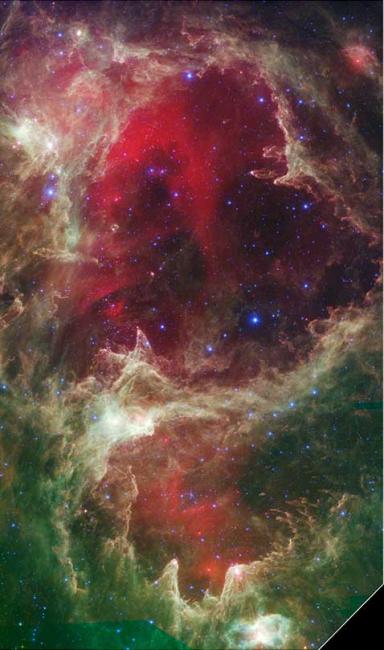
A false-color infrared image of the giant star-forming region called W5 as seen by
the Spitzer Space Telescope. The image spans an area of sky equivalent to four full moons.Small, elongated, dust-filled globules are found near hot young stars in this region; four of them are located in the small, wispy red "cove" near the top of the image.
New stars tend to form with disks of gas and dust around them. After a few hundred thousand years or so, the intense ultraviolet radiation from the most massive of these stars has expelled much of the gas in the outer portion of the nearby disks, and scientist think that the escaping gas takes some of the dust along with it. That dust can be seen at infrared wavelengths as cool, comet-shaped globules. Since these disks are the birthplaces of planets, the processes involved in producing globules will impact the formation and subsequent evolution of planets. Hence astronomers are very interested in the diagnostic clues provided by cometary globules.
The Spitzer Space Telescope with its infrared cameras is able to study many of these dim cometary globules for the first time. Three SAO astronomers, Xavier Koenig, Lori Allen, and Scott Kenyon, along with two colleagues, have imaged the giant star forming region called W5 over an area in the sky about the size of four full moons, and discovered four such globules. They report in this week's Astrophysical Journal Letters that their data indicate the dust in these globules was not completely removed with the gas.
Instead, the dust appears to have remained in the disk but only later was blown out by radiation pressure from the nearest massive star. The difference is important because of the new timescale it implies. Rather than being removed from the disk with the gas in tens of thousands of years, as had once been suggested, the new results suggest that the dust can survive in the disk for a few million years. Planets, after they form from these disks, can migrate inward towards their star on a timescale of hundreds of thousands of years. These new results address the environment of planets during this early phase of their evolution.